OCEAN VIRUSES and EARTH’S CARBON CYCLE
Our work is centered on the grand challenge of viruses and their impact on Earth’s carbon cycle, arguably the most impactful process on Earth that critically shapes ecosystems, resources, climate and humanity. The oceans are by far the biggest reservoir of C and are critical for its long-term sequestration on geological time-scales. The processes that regulate the fate of carbon are multifaceted and multidisciplinary and have largely been studied in isolation.
Furthermore, the role of viruses in regulating carbon flow and its interaction with physics, chemistry biomineral formation, and ecosystem coupling have largely been ignored. Our team has shown that viruses need to feature prominently and we need to understand how and to what extent and do so across disciplines if we want to predict carbon cycling in the face of environmental change.
The fluid nature of the oceans profoundly impacts host-viral interactions, particle formation and export in ways we don’t understand and can only understand by convergence. Our project aims to develop predictive models that span these spatial and temporal scales
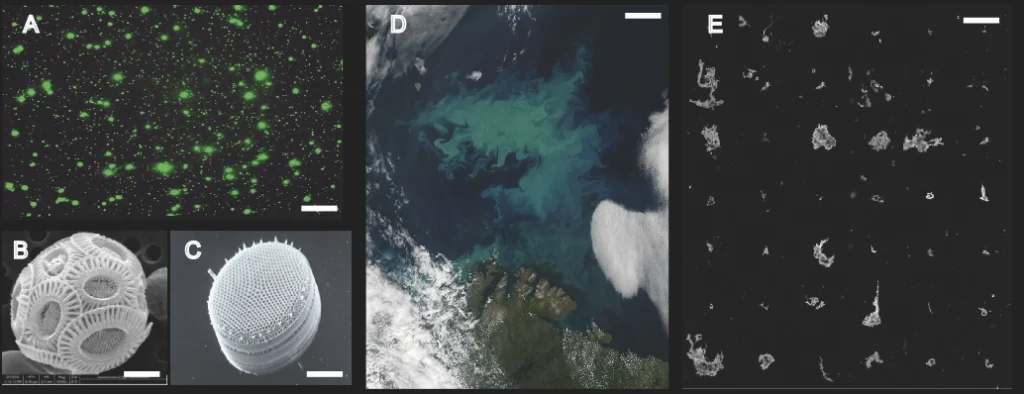
Viruses are the most abundance entities in the oceans by far, with 10 million of them in a drop of seawater and 1030 across the total volume of the oceans. Scientists can visualize and count them by staining their genetic code (e.g., DNA) (smaller green dots in panel A). They routinely infect marine microbes (larger green dots in panel A) and marine phytoplankton like coccolithophores (panel B) and diatoms (panel C), which form massive ‘blooms’ that span tens to hundreds of kilometers and can be detected by Earth-observing satellites (turquoise water in panel D). Both coccolithophores and diatoms are photosynthetic and drift with the currents. Collectively with other phytoplankton they account for 50% of the photosynthesis and oxygen production on the planet and are the base of marine foodwebs. They also make hard, heavy ‘biomineral’ exoskeletons made of calcium carbonate plates (chalk; panel B) and silica (glass; panel C) that serve as ballast to sink and sequester organic matter (carbon) to the deep oceans. This is a critical component of Earth’s carbon cycle. When viruses infect coccolithophores and diatoms they cause them to become ‘sticky’ and to aggregate, forming a range of much larger particles (panel E) that sink much faster than individual cells can, potentially enhancing the ability of the oceans to sequester carbon for hundreds to thousands of years. GCR scientists are using transdisciplinary research– conducted by investigators from different disciplines working jointly to create new conceptual, theoretical, methodological, and translational innovations that integrate across discipline-specific approaches to address a common problem or grand challenge–investigating the role that these cell-virus interactions play in Earth’s carbon cycle and the role that ocean physics (turbulence) and ecosystem dynamics (interactions with planktonic animals; zooplankton) play in aggregate formation and sinking fate of carbon. Scale bars correspond to: (A) 4 µm; (B-C) 1 µm; (D) 50 km; (E) 2 mm. Photo credits: (A) G. Steward; (B-C) K. Bidle; (D) NASA; (E) M. Prakash.
Can we make conceptual and quantitative bridges between the microscale to mesoscale?
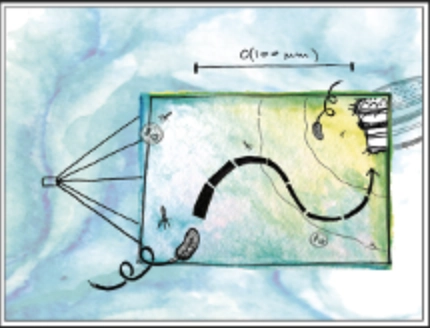
Stocker (2015) Aquat Micro Ecol 76: 189-194
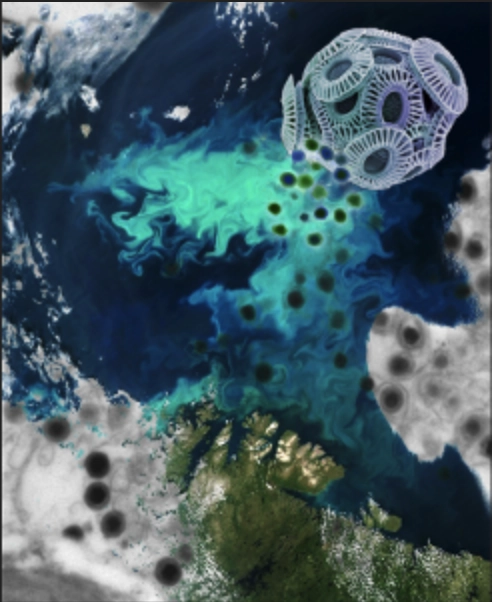
As the smallest (nanometers in diameter) and most abundance entities in the oceans (107 ml-1), viruses reside and interact with their microbial hosts in the microscale (microns). Indeed, the order 100 µm scale—O(100 µm) scale—as proposed by Stocker2015, represents the relevant scale at which viruses interact with their host cells in the ocean. It’s at this scale that primary rules that control encounters and contact between microscopic particles (like viruses, cells, bacteria).
Yet, at the same time, these interactions can manifest in the mesoscale (100s of kilometers) and are observable by Earth observing satellites as blooms of phytoplankton (like coccolithophores and diatoms) become infected and go through physiological changes. These changes include for aggregation and formation of sticky marine snow particles—which at its core, also requires encounters between sticky particles in the microscale— that result in the export of particulate organic carbon (POC) from the surface ocean to the deep ocean interior.
This process—the gravitational carbon pump—sequesters carbon for 100s to 1000s of years and is THE conduit of carbon flow from the atmosphere to the oceans and it is mediated by biology. Our project aims to understand and make conceptual and quantitative bridges of how virus-host interactions span these spatial scales to have such a pronounced impact.
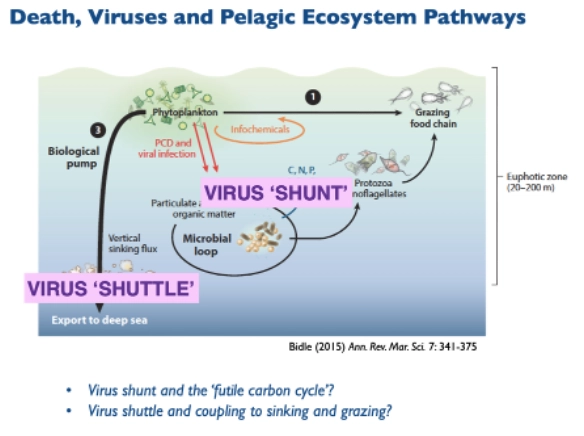
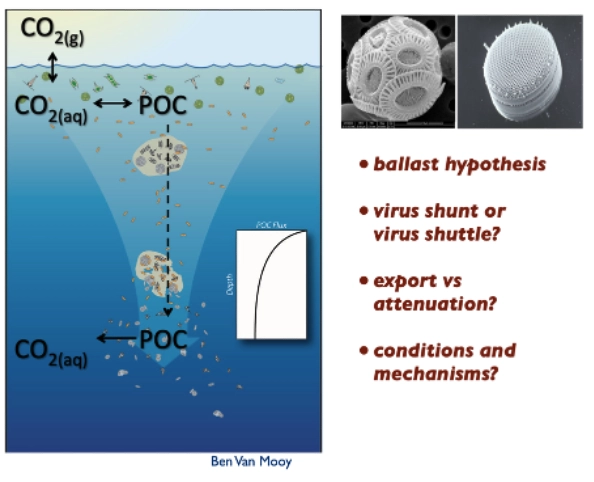
A key aspect of understanding how viruses impact the flow of carbon in the oceans is to quantify their contributions to two competing ecosystem/biogeochemistry pathways…the ‘virus shunt’ versus the ‘virus shuttle’.
The ‘virus shunt’ has been a classic paradigm for viruses for decades and has shaped our traditional knowledge. It involves virus infection leading to lysis (‘exploding’) cells during infection and releasing organic contents which attenuates carbon in the upper ocean and stimulates microbial respiration—effectively preventing carbon from flowing to the deep sea.
The ‘virus shuttle’ is a newer construct that is revising our understanding of how viruses impact the flow of carbon in the ocean. It involves virus infection leading to enhanced stickiness of cells (similar to us getting mucousy when we have a cold) and then the physics of the ocean can bring these sticky cells together to form marine snow aggregates that rapidly sink (100s of meters per day)—effectively pumping and sequestering carbon from flowing to the deep sea.
The form, fate and flow of carbon during these two processes is radically different. We want to better understand and quantify the relative contribution of viruses to these pathways, especially for ballasted phytoplankton–coccolithophores and diatoms—whose biominerals (calcium carbonate and silica) serve to more efficiently sink organic matter and marine snow.
